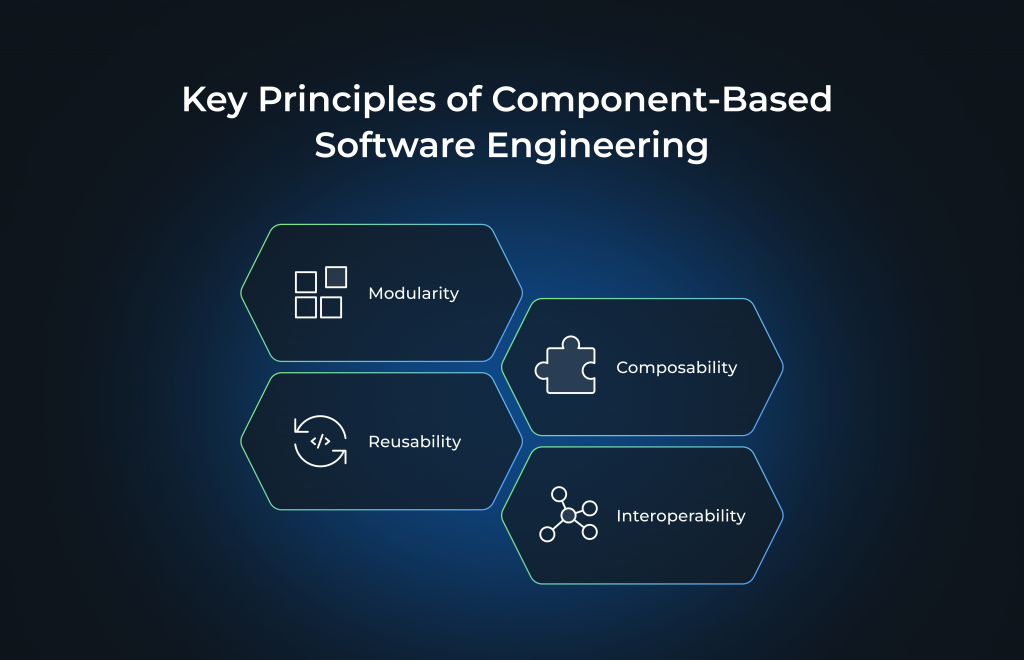Embark on a journey through Component-Based Software Engineering (CBSE), a transformative approach redefining software development. This article delves into CBSE’s architecture, principles, advantages, challenges, and the future landscape. At WeSoftYou, a leading software development company, we navigate the intricacies of CBSE to deliver robust solutions.
Key Takeaways:
- CBSE Fundamentals: Understand CBSE’s core principles, emphasizing modularity, reusability, composability, and interoperability.
- Architecture Insight: Explore the architecture of CBSE, revealing the roles of components and connectors, crucial for comprehending its essence.
- Advantages of CBSE: Discover how CBSE boosts efficiency, flexibility, scalability, and reusability, providing a structured and efficient development approach.
- Challenges in CBSE: Acknowledge integration complexities and maintenance challenges, vital aspects in successfully implementing CBSE.
- Future Trends: Delve into the evolving landscape of CBSE, driven by microservices adoption, containerization technologies, and a shift towards modular and reusable development.
- Wesoftyou Expertise: Benefit from Wesoftyou’s proven track record and expertise in CBSE, ensuring innovative and reliable software solutions tailored to your needs.
- Consultation and Collaboration: Contact Wesoftyou for a free consultation or project estimation, experiencing the full potential of CBSE for your software development requirements.
Understanding the Basics of Component-based Software Engineering
CBSE revolutionizes the way software systems are built by breaking them down into modular components. These components can be developed and maintained independently, allowing for better reusability and scalability. Let’s delve into the definition and importance of CBSE, as well as the key principles that drive this approach.
Component-based Software Engineering (CBSE) is an approach to software development where complex systems are built by assembling reusable software components. These components encapsulate specific functionality and can be developed independently, promoting code reusability across different projects. This approach enables faster development cycles, reduces time-to-market, and enhances software quality.
From our experience, CBSE offers several benefits. Firstly, it allows for the modular development of software systems, making it easier to manage and maintain them. With modular components, developers can focus on specific functionalities, resulting in more efficient development processes. Additionally, it promotes code reuse, reducing redundancy and improving overall development efficiency. By leveraging proven and tested components, developers can save time and effort in building software systems from scratch. Moreover, CBSE facilitates better collaboration among development teams, as they can focus on specific components, minimizing conflicts in code integration.
Definition and Importance of Component-based Software Engineering
CBSE is an approach to software development where complex systems are built by assembling reusable software components. These components encapsulate specific functionality and can be developed independently, promoting code reusability across different projects. This approach enables faster development cycles, reduces time-to-market, and enhances software quality.
From our experience, CBSE offers several benefits. Firstly, it allows for the modular development of software systems, making it easier to manage and maintain them. With modular components, developers can focus on specific functionalities, resulting in more efficient development processes. Additionally, it promotes code reuse, reducing redundancy and improving overall development efficiency. By leveraging proven and tested components, developers can save time and effort in building software systems from scratch. Moreover, CBSE facilitates better collaboration among development teams, as they can focus on specific components, minimizing conflicts in code integration.
Another important aspect of CBSE is its ability to enhance software quality. By using reusable components, developers can leverage existing solutions that have been thoroughly tested and proven to work effectively. This reduces the risk of introducing bugs and errors into the software system. Additionally, the modular nature of CBSE allows for easier debugging and maintenance, as issues can be isolated to specific components.
Key Principles of Component-based Software Engineering

Component-Based Software Engineering (CBSE) operates on fundamental principles: modularity, reusability, composability, and interoperability. These principles drive the development of independently deployable and reusable software components, fostering efficient, scalable, and collaborative software systems.
- Modularity refers to the ability to break down software systems into independent and cohesive components. These components should have clear interfaces and minimal dependencies on other components, enabling separate development and maintenance. By dividing a complex system into smaller, manageable parts, developers can focus on specific functionalities, resulting in more efficient development processes.
- Reusability is a fundamental principle of CBSE, allowing components to be reused across different projects. This reduces development effort and enhances software quality, as proven and tested components are leveraged. By building a library of reusable components, developers can save time and effort in future projects, while ensuring the reliability and stability of the software system.
- Composability emphasizes the ability to assemble components to build complex systems. Using well-defined interfaces, components can be combined to create customized solutions, fostering flexibility and adaptability. This principle allows developers to create software systems that meet specific requirements by selecting and integrating the appropriate components. It also enables the system to evolve and adapt to changing needs, as components can be easily replaced or updated.
- Interoperability is crucial in CBSE, ensuring that components can work together seamlessly. Standardized communication protocols and well-defined interfaces enable components developed by different teams to integrate smoothly. This principle promotes collaboration and compatibility among different software systems, allowing for the exchange of data and functionality. By adhering to interoperability standards, developers can ensure that their components can be easily integrated into various software ecosystems.
The Architecture of Component-based Software Engineering
The architecture of a Component-based Software Engineering (CBSE) system is composed of two main elements: components and connectors. Understanding their roles is essential to grasp the essence of CBSE.
Components and Their Roles
Components are self-contained units of software that encapsulate specific functionality. They are like building blocks that can be combined to create complex systems. Components expose well-defined interfaces, allowing them to be invoked by other components or clients. This modular approach to software development promotes reusability and maintainability.
Each component in a CBSE system has a specific role to play. Some components handle user interfaces, while others handle business logic or data storage. By dividing the system into smaller, manageable components, developers can focus on specific functionalities, making the system easier to understand and maintain.
Components are designed to be reusable, independent, and replaceable. This means that they can be used in different projects or systems without modification. Additionally, if a component becomes outdated or needs improvement, it can be easily replaced with a newer version or an alternative component, without affecting the rest of the system.
Connectors play a vital role in CBSE by facilitating communication and interaction between components. They are responsible for establishing coordination and synchronization among components, ensuring the system functions as intended. Connectors can be categorized into different types, such as procedural connectors, data connectors, event-based connectors, or message-based connectors – each serving a specific purpose in the system architecture.
Advantages of Component-based Software Engineering
CBSE offers numerous advantages over traditional monolithic software development approaches. Two significant advantages include increased efficiency and flexibility, as well as improved scalability and reusability.
Increased Efficiency and Flexibility
CBSE enables accelerated development cycles and faster time-to-market. With independently developed and reusable components, development teams can work concurrently, reducing overall development time. This approach also enhances flexibility, as components can be easily replaced, upgraded, or modified without impacting the entire system. This adaptability allows organizations to respond quickly to changing business needs and technological advancements.
Furthermore, CBSE promotes code reuse, eliminating the need to reinvent the wheel for every project. Reusing existing components not only saves time but also ensures consistency and reliability across different systems. Developers can focus on creating new components that address specific requirements, rather than starting from scratch for every project.
Improved Scalability and Reusability
Scalability is a critical aspect of a successful software system. CBSE promotes scalability by supporting the reusability of components. As components are designed to be independent and modular, they can be reused in multiple projects, saving time and effort. This reusability also allows for easy scalability, as organizations can add or remove components as needed to meet changing requirements.
Moreover, CBSE enables organizations to scale their systems without significant architectural changes. By adding or removing components, the system can adapt to increased or decreased workloads. This flexibility ensures that the system remains efficient and responsive, even as the demands on it change over time.
In conclusion, CBSE provides a structured and efficient approach to software development. By leveraging the power of reusable components and well-defined connectors, CBSE systems are easier to develop, maintain, and scale. The advantages of CBSE, such as increased efficiency, flexibility, scalability, and reusability, make it a preferred choice for building complex software systems.
Challenges in Component-based Software Engineering
While CBSE offers significant advantages, it also presents certain challenges that need to be addressed to ensure successful implementation.
One of the key challenges in component-based software engineering is integration. Integrating independently developed components can be complex, particularly when dealing with components from different teams or third-party vendors. Each component may have its own unique set of dependencies, making it difficult to seamlessly integrate them into a cohesive system. Consistent communication protocols and well-defined interfaces are critical to ensuring seamless integration. Without proper coordination and planning, integration issues can lead to compatibility problems, system failures, and delays in project delivery.
In addition to integration challenges, maintenance and upgradation pose significant obstacles in CBSE. As components are meant to be reusable and maintainable, proper maintenance and upgradation strategies play a crucial role in ensuring the longevity and effectiveness of the software system. Managing version changes becomes a critical task, as updates to one component may have implications on other components that depend on it. Ensuring backward compatibility becomes essential to prevent disruptions in the system. Furthermore, maintaining a well-organized and up-to-date component library is necessary to facilitate efficient reuse and minimize redundancy. Careful planning and coordination are required to address these maintenance and upgradation challenges effectively.
Overall, while component-based software engineering offers numerous benefits, it is essential to acknowledge and overcome the challenges that come with it. By addressing integration issues and implementing effective maintenance and upgradation strategies, organizations can harness the full potential of CBSE and build robust, scalable, and maintainable software systems.
The Future of Component-based Software Engineering
Component-based software engineering (CBSE) is a dynamic field that is constantly evolving to keep up with emerging trends and innovations in software development. The future of CBSE holds exciting possibilities that will shape the way software is built and maintained.
One of the key factors driving the future of CBSE is the adoption of microservices architecture. This architectural style allows for the development of highly modular and independently deployable components. With microservices, developers can break down complex systems into smaller, more manageable components, enabling faster development cycles and improved scalability. This trend is gaining momentum as organizations realize the benefits of building software systems using a collection of loosely coupled services.
Another emerging trend in CBSE is the increased use of containerization technologies, such as Docker and Kubernetes. Containers provide a lightweight and isolated runtime environment for components, enhancing portability and deployment flexibility. By encapsulating components and their dependencies, containers enable seamless deployment across different environments, making it easier to scale and manage software systems.
The impact of CBSE on software development practices is profound. It promotes a shift towards a more modular and reusable approach, where teams can focus on developing specialized components that can be easily integrated into larger systems. This fosters collaboration and code sharing among developers, leading to increased productivity and efficiency. CBSE also aligns with the principles of agile development methodologies, enabling iterative and incremental development. This iterative approach allows for faster feedback loops, ensuring that software meets customer requirements and increases overall customer satisfaction.
In conclusion, component-based software engineering is a powerful approach that revolutionizes software development. Its modular architecture, reusability, and flexibility make it an ideal choice for organizations looking to enhance development efficiency and deliver high-quality software solutions. With the emergence of new trends and innovations, CBSE continues to shape the future of software development, enabling organizations to stay ahead in a rapidly evolving digital landscape.
As a software development company with proven expertise, Wesoftyou recognizes the potential of CBSE and is well-equipped to assist organizations in harnessing its benefits. Our team of experienced developers stays up-to-date with the latest trends and best practices in CBSE, ensuring that we deliver innovative and reliable software solutions to our clients. Contact us today to learn more about how we can help your organization leverage the power of CBSE for your software development needs.
For a free consultation or project estimation, please contact us at Wesoftyou.
FAQ
Component-based software engineering (CBSE) offers several advantages that make it a popular approach in today’s software development industry. One of the key advantages is the reusability of components. With CBSE, developers can create software components that can be easily reused in different projects, saving time and effort. This not only improves productivity but also enhances the quality of the software by leveraging well-tested and proven components.
Another advantage of CBSE is improved scalability. By designing software systems as a collection of independent components, it becomes easier to scale the system horizontally by adding more instances of the components. This allows for better performance and the ability to handle increasing workloads without significant changes to the overall architecture.
Furthermore, CBSE promotes modularity, which leads to better maintainability of the software. With components being self-contained and loosely coupled, making changes or updates to one component does not affect the entire system. This makes it easier to debug, test, and maintain the software, reducing the overall cost of development and maintenance.
Scalability is a critical aspect of software systems, especially in today’s fast-paced and ever-growing digital landscape. Component-based software engineering provides a scalable solution by breaking down the system into independent components that can be easily replicated and distributed across multiple servers or instances. This allows for efficient utilization of resources and the ability to handle increasing workloads by adding more instances of the components.
Reusability is another key advantage of CBSE. By designing software components that are self-contained and independent, they can be easily reused in different projects or within the same project. This saves development time and effort, as developers can leverage existing components instead of reinventing the wheel. Reusable components also undergo rigorous testing and quality assurance, ensuring that they are reliable and robust.
Moreover, the reusability of components promotes consistency and standardization across different software projects. By using the same set of components, organizations can establish best practices and guidelines, leading to improved quality and maintainability of the software.
While component-based software engineering offers numerous benefits, there are also challenges that need to be addressed during implementation. One of the key challenges is the identification and selection of suitable components. With a wide range of available components, it can be challenging to find the right ones that align with the project requirements and quality standards. Additionally, ensuring compatibility and integration between different components can be complex, especially when dealing with components from different vendors or sources.
Another challenge is the management of dependencies between components. As components rely on each other to function properly, it is crucial to handle dependencies effectively to avoid conflicts or versioning issues. This requires careful planning and coordination between different teams or developers working on the project.
Furthermore, maintaining the documentation and version control of components can be a challenge. With a large number of components being used and reused, it is essential to have a robust system in place to track changes, updates, and compatibility across different versions of the components.
Component-based software engineering has a significant impact on software development practices, leading to more efficient and effective development processes. One of the key impacts is the shift towards a modular and reusable approach. Developers focus on creating independent components that can be easily integrated into different systems, promoting code reuse and reducing duplication. This modular approach also enables parallel development, where different teams can work on different components simultaneously, improving overall productivity.
Moreover, CBSE encourages the use of standard interfaces and protocols, enabling interoperability between different components and systems. This promotes collaboration and integration between different software solutions, allowing organizations to leverage existing components and systems to build more comprehensive and powerful applications.
Additionally, CBSE emphasizes the importance of testing and quality assurance. With components being reusable, it is crucial to ensure that they are thoroughly tested and meet the required quality standards. This leads to the adoption of rigorous testing practices, such as unit testing, integration testing, and regression testing, to ensure the reliability and robustness of the components.





















